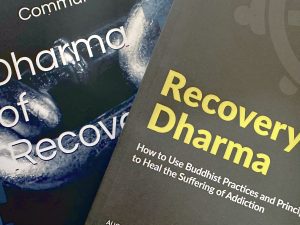A short topic written for reading at a weekly Recovery Dharma meeting.
Mindfulness of breathing is probably the most common way to introduce ourself or others to the practice of meditation. When giving instructions for mindfulness meditation, the Buddha began by using breath as a way of calming the mind and gaining insight. In the traditional Buddhist scriptures, his instructions were simple: to breathe knowing one is breathing, to breathe knowing the quality of one’s breath, to breathe into the entire body, and to breathe as a way of calming the body.
The instructions may be simple but they aren’t always easy to accomplish. The mind has the tendency to become distracted by other sensations, whether they are sounds or bodily discomforts or thoughts. Our aim is to maintain our attention on the sensation of breathing. When the mind gets lost in thought (and it often will), we gently note the distraction as whatever it may be and then return our attention to the sensation of breathing.
Breathing in long, he knows ‘I breathe in long,’ breathing out long he knows ‘I breathe out long.’ Breathing in short, he knows ‘I breathe in short,’ breathing out short, he knows ‘I breathe out short.’ He trains thus: ‘I shall breathe in experiencing the whole body,’ he trains thus: ‘I shall breathe out experiencing the whole body.’ He trains thus: ‘I shall breathe in calming the whole body,’ he trains thus: ‘I shall breathe out calming the whole body.’
SATIPATTHĀNA SUTTA, MAJJHIMA NIKAYA 10
During formal meditation practice, it may be helpful to begin by choosing a specific part of the body upon which to pay attention to the breath. For some, this may be the nostrils and upper lip. For others, this may be the back of the throat. Many people use the rising and falling of the chest or abdomen as points of focus. Finally, the entire movement of breath, from the abdomen all the way to the nostrils, may be the object of our mindfulness practice. Whatever part of the body we choose, it is important to stick with it for the duration of the meditation – this ensures that our mind doesn’t wander all over the body.
Some meditators find it helpful to begin each session of breath meditation with breath counting. One may gently, silently note each breath with a number, counting up to five or ten, and then counting back to zero. When the mind becomes distracted and loses count, one simply starts counting at one again. Our experiences have shown that five to ten minutes of breath counting often has a calming effect on the mind; once the mind has become relatively stable, one may let go of counting and bring attention to the full sensation of breathing.
What types of sensations are we looking for while breathing? Part of the practice of mindfulness is investigation, so it becomes important to inquire into the qualities of our breath. Is the breathing long or short? Is it smooth or restricted? How does breathing in and out change the sensation of softness or hardness in the body? Does an individual breath have sensations of warmth or coolness? Does breathing change through time, as the meditation proceeds? This sort of investigation is not overly analytical and need not involve complex thinking. For example, it can be as simple as noting “rising” as one breathes in, or “smooth” as one breathes out.
With mindfulness practice, simplicity is key.





